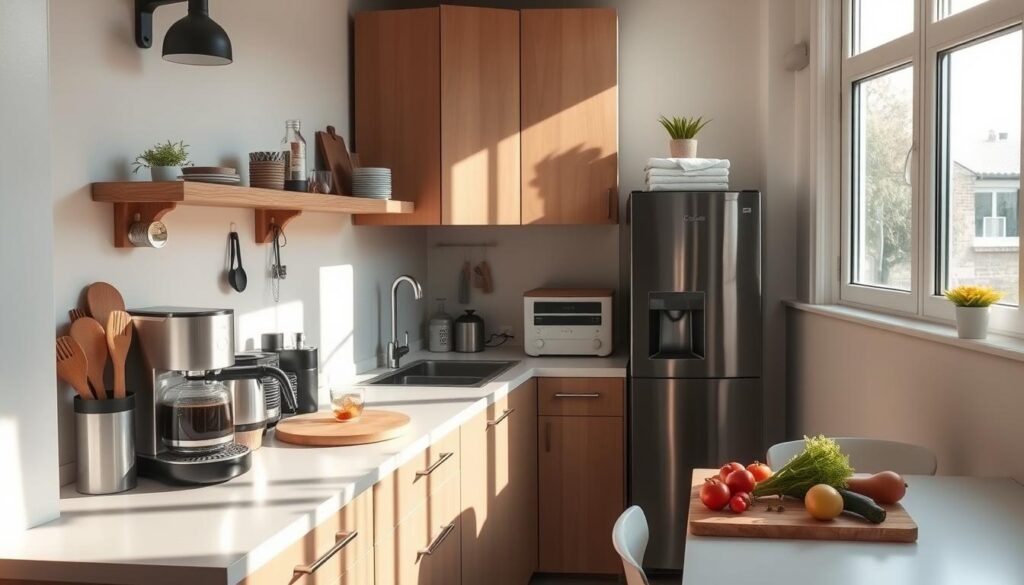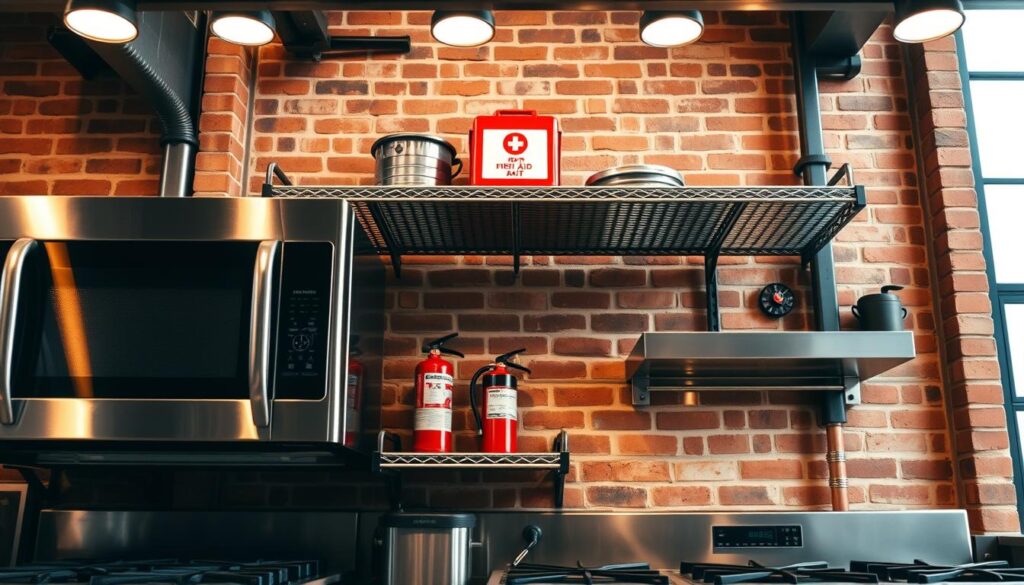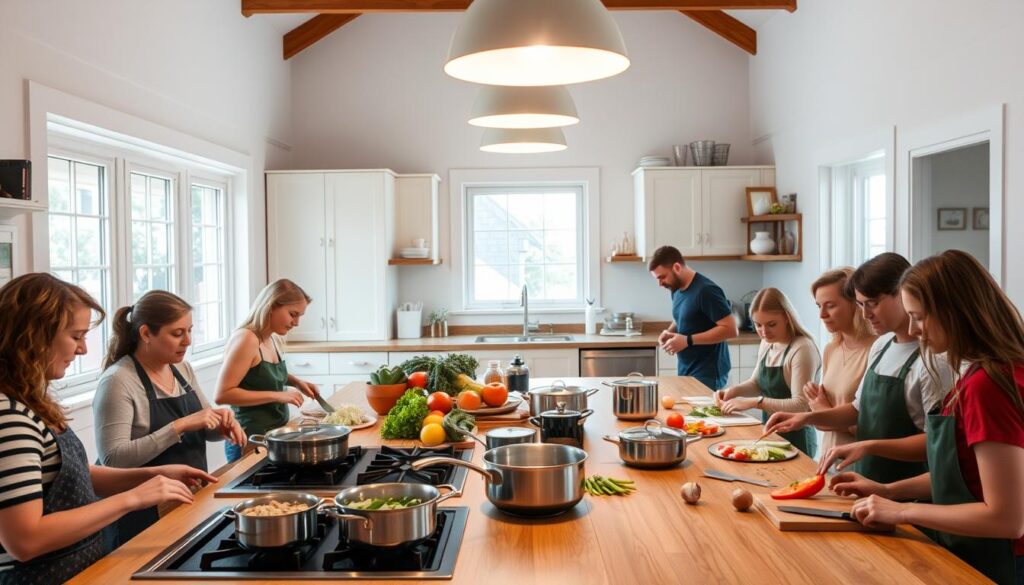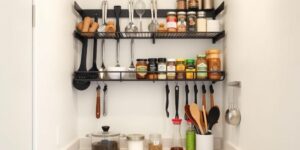How to Set Up a Shared Kitchen Without Losing Your Mind
Get shared dorm kitchen tips to simplify meal prep and reduce stress. Follow our guide to creating a harmonious kitchen environment.
College living often means tiny rooms and creative setups. They can loft beds to free up floor space and tuck a fridge and microwave under the raised bed. With a simple plan, a student can turn a cramped corner into a practical food prep zone.

Low-cost hacks make a big difference. An over-the-toilet metal shelf placed beside a mini fridge adds vertical storage for snacks and plates. Swapping a fridge hinge fixes a door that opens the wrong way and eases daily use.
Use open-front bins from Target and wire baskets from Amazon to keep food visible. Measure shelves before you buy containers so everything fits. A rolling metal cart can be zoned: top for dishes and utensils, middle for paper goods, bottom for cleaners.
Readers will learn a step-by-step approach that keeps the setup fast and low-stress. With the right storage and habits, this shared kitchen space becomes tidy, safe, and reliable for quick meals.
Key Takeaways
- Start with a short plan that matches the room layout.
- Use vertical storage to maximize limited space.
- Fix fridge door issues with a hinge swap for easier access.
- Choose open-front bins and baskets for visible storage.
- Zone a rolling cart to keep daily items within reach.
- Measure before buying to avoid fit problems.
Why Shared Dorm Kitchens Feel Chaotic—and How This Guide Makes Them Easy
Hallway kitchens on busy floors cram many students into one small, hectic space. Limited equipment, tight counters, and overlapping schedules create crowding and stress for everyone.
Poor ventilation makes smells linger; broccoli, bacon, or burned popcorn can set off alarms and force an entire building to evacuate. Best practice is to cook pungent foods during the day, open windows when possible, and use the vent or fan.
What Else Would You Like to Know?
Choose below:
Simple etiquette cuts drama: wipe counters, toss trash, and never leave dishes overnight so the next person finds a clean area. Label food with a name and date or add a “help yourself” tag to avoid passive-aggressive notes.
- Plan cook time during low-traffic hours to reduce wait and odor complaints.
- Keep gear consolidated to minimize clutter and noise for other people on the floor.
- When the room is packed, pivot to a simpler meal or come back later to save time.
This guide breaks the chaos into clear steps—prep, storage, etiquette, safety, and easy recipes—so college students can use the shared space with less conflict and more trust.
For compact snack organization ideas that work in tight food areas, see smart snack organization.
Start Smart: Plan Your Cook Time, Menu, and Gear Before You Enter the Kitchen
A quick plan before you step into the cooking area saves time and avoids stress. A short checklist keeps a student focused and respectful of others using the room. Prep at the desk when possible so the shared space is used only for final steps and cleanup.
Prep in your room
Pre-measure ingredients into sealed containers and pack a tiny utensils kit. That kit should include a knife, small cutting board, spatula, towel, and at least one lidded container.
Pick low-traffic windows
Choose early morning, mid-afternoon, or late-evening slots to reduce lines and pressure. Timebox the session—set a target finish time so the appliance becomes free again quickly.
Minimal gear checklist
- Write a short plan with recipe steps, exact cook time, and appliance choices.
- Bring only what the recipe needs to keep your footprint small in the space.
- Favor mini setups: one pot, one pan, or one microwave-safe bowl when possible.
Maximize Kitchen Space: Storage and Setup Ideas That Actually Work in Dorms
Small living quarters demand clever storage that keeps gear reachable and clutter out of the way. Start by thinking vertical: a metal over-the-toilet shelf becomes a mini kitchenette frame beside or above a mini fridge. It costs roughly $25 and mimics pricier furniture while saving floor space.
Appliance placement and cord management
Place the mini fridge and microwave so cords reach outlets cleanly. Use a dorm-approved surge protector and run cords along the wall to avoid trips. If the fridge door hits a wall, swap the hinge so it opens into open space for easier access.
Zone a rolling cart
Zone a rolling metal cart: top for plates and utensils, middle for paper goods, bottom for cleaners. Keep heavier items low and lighter things high to keep the setup stable in a tight room.
Bins, baskets, and shelves that fit
Measure shelves before you buy. Mix open-front crates for visibility with wire baskets for odd gaps. Label each shelf by category so everyone returns items to the same place and the shared area stays tidy.
- Use vertical storage to free up floor space.
- Keep microwave clearance per manufacturer guidance, especially dorm layouts.
- Label zones and store heavier items low for safety.
| Zone | Typical items | Ideal shelf height |
|---|---|---|
| Top | Plates, cups | Above eye level |
| Middle | Snacks, paper goods | Waist to chest |
| Bottom | Appliances, cleaners | Floor to knee |
shared dorm kitchen tips: Etiquette, Boundaries, and Respect in a Shared Space
Good manners in a communal cooking area start with small actions that save time and headaches for everyone. These habits protect the room and reduce friction among people on the floor. Students who adopt a few rules make the space safer and more pleasant for roommates and neighbors.
Leave it better than you found it
Wipe counters, clear crumbs, and empty small trash before leaving. A quick wash-and-dry cycle prevents sink backups and moldy odors from dishes left overnight.
Labeling sets clear boundaries
Use masking tape with a name and date on containers. Add a “help yourself” note if something is meant to be shared. This avoids confusion and reduces passive-aggressive notes.
Control smells, smoke, and heat
Avoid cooking pungent foods late. Run vents or fans and open windows when allowed. Monitor pans on low heat to prevent smoke that can trigger alarms and evacuations.
- Limit time at the stove or sink when others wait.
- Consolidate setup to one compact area to reduce clutter.
- If problems persist, report politely to an RA instead of escalating with notes.
| Problem | Quick Fix | When to Escalate |
|---|---|---|
| Overnight dishes | Wash, dry, and store before bed | Repeated offenses after a polite request |
| Unlabeled food | Mark with name and date | Items go missing regularly |
| Strong odors or smoke | Use vent/fan and lower heat | Multiple alarms or complaints |
Fridge, Freezer, and Pantry Strategy: How to Store Food Without Drama
Smart labeling and small bins make storing food feel simple, not chaotic. A clear label routine prevents confusion and keeps items moving out before they spoil.
Standardize labels: write name, date, and “share/no share” so ownership is obvious. Masking tape and a fine-tip marker work well and peel off cleanly.
Label cadence
Use a short label format: NAME | DATE | SHARE/NO. This reduces arguments and helps roommates decide fast when grabbing snacks or meal parts.
Mini fridge organization
Zone the mini fridge: top for grab-and-go breakfasts, middle for meal components, bottom for drinks to balance weight. Keep raw meat or mess-prone items on separate trays to avoid cross-contamination.
- Use meal-ready bins to group recipe components for quick cook sessions.
- Dedicate a snack shelf for bars, fruit cups, and yogurt to speed mornings.
- Measure shelf widths so two open-front bins fit side by side for efficient storage.
- Rotate weekly: toss old items and check dates to keep the fridge odor-free.
| Zone | Best items | Why it works |
|---|---|---|
| Top | Yogurt, muffins, granola bars | Easy reach for busy mornings |
| Middle | Prepped meal bins, sauces | Visible, at eye level for cooking |
| Bottom | Beverages, heavy jars | Low center of gravity; easier lifting |
Safety First: Fire Alarms, Heat, and Staying Close to the Stove or Microwave
Preventing a fire alarm starts with simple habits around heat sources. Staying within arm’s reach of a stove or microwave when it is on cuts the risk of a smoky mishap. Unattended pans and overcooked snacks are common causes of building-wide alarms.

Run the vent or fan and open a window if rules allow. Use moderate heat and enough oil to avoid scorching. Keep lids nearby to smother small flare-ups before smoke spreads through the shared kitchen.
- Stay close while any heat is active; unattended cooking triggers alarms fast.
- Use microwave-safe containers and cover food with a vented lid or paper towel to prevent boil-overs.
- Clean spills promptly so residue does not burn the next time someone uses the appliance.
- Time meals to avoid late-night high-heat searing that creates smoke and disturbance.
| Hazard | Prevention | Immediate Action |
|---|---|---|
| Scorching on stovetop | Cook on moderate heat | Lower heat, cover, ventilate |
| Microwave boil-over | Use vented lids | Stop, open door, wipe spill |
| Lingering smoke | Run fan and open window | Evacuate if alarms sound, notify campus safety |
Low-Mess, High-Reward Meals for Shared Kitchens
Meals that chill overnight or cook in one bowl reduce time at the counter. These ideas keep cleanup tiny and let a student grab a breakfast or snack without blocking the top appliance.
Make-ahead breakfasts and no-cook lunches
Overnight oats and chia pudding sit in the mini fridge and are ready in the morning. They use pantry ingredients like oats, milk, and seeds and need only a jar and spoon.
Quick warm bowls and single-pot pasta upgrades
Warm tahini ramen is a one-pot, creamy noodle bowl. Ramen carbonara turns instant noodles into a richer pasta-style meal that can even finish in the microwave when time is tight.
Fast desserts and no-cook proteins
A mug brownie satisfies late-night cravings with almost no gear. Mediterranean chickpea salad or chickpea “tuna” sandwiches give protein with zero cooking, so they work well on a busy floor.
Sheet-tray options for communal ovens
Quesadillas or baked potatoes on one tray keep ingredients contained and cleanup low. Get creative with toppings to vary flavors without extra pans.
- Favor oats, chickpeas, and instant noodles to cut fridge clutter.
- Keep portions small so a meal finishes fast and others can use the space.
| Recipe | Why it works | Best tool |
|---|---|---|
| Overnight oats | Cold, no-cook, grab-and-go | Jar |
| Ramen carbonara | Upgraded instant pasta with little cleanup | Microwave or pot |
| Mug brownie | Single-serving dessert, minimal dishes | Microwave |
Weekly Meal Workflow: Cook With Friends, Save Time, and Reduce Dishes
A weekly cook-up turns a crowded meal scramble into a smooth, social routine. Students report that group cooking makes meals more fun and cuts the cleanup load. Choosing a regular slot keeps the floor clear and lowers appliance wait times.

Batch in off-hours
Pick an off-hour to batch one-pot pasta or a single sheet-tray meal. These methods use fewer pots and reduce the number of dishes to wash. Off-hours mean easy access to counters and ovens.
Split tasks and share cleanup
Divide roles—chop, cook, and clean—so the process moves fast. Store labeled portions in lidded containers so everyone knows what’s theirs. Keep a strict time limit and a short cleaning sequence to respect others waiting to use the kitchen.
- Choose a weekly slot to avoid busy floor rushes.
- Prefer one-pot or sheet-tray plans to minimize dishes.
- Prep mini tasks (wash greens, measure spices) in the room to save time.
- Rotate recipes weekly so the routine stays fresh and efficient.
| Step | Why it helps | Action |
|---|---|---|
| Plan | Secures counter space | Pick an off-hour and list ingredients |
| Execute | Speeds prep | Assign roles and work in parallel |
| Reset | Keeps area usable | Clean by sequence and store portions |
Essential Dorm Kitchen Kit on a Student Budget
A smart, pared-down kit helps a student cook well without taking over a small room. Focus on multiuse items that fit on a shelf and in a drawer so the shared cooking area stays clear.
Top tools to pack
Prioritize essentials: a microwave-safe bowl, lidded containers, a can opener, and a compact measuring set cover most meals. Add a small knife, mini cutting board, and a basic set of utensils to round out what a student needs.
Affordable storage solutions
Use a $25 over-the-toilet shelf beside the mini fridge to add vertical storage. A rolling cart works well when zoned: top for dishes and utensils, middle for paper goods, bottom for cleaning supplies.
- Measure shelves before buying open-front bins and wire baskets so two fit side by side.
- Use clear containers and labels to store food and avoid confusion.
- Keep a small caddy for cleaning supplies so wiping surfaces and quick washups are easy.
What to skip
Avoid bulky appliances and duplicate specialty items that hog space. Use a single surge protector and tidy cords to keep power safe and the room uncluttered.
| Item | Purpose | Where to store |
|---|---|---|
| Microwave-safe bowl | Heat and serve | Top shelf or cart top |
| Over-the-toilet shelf | Vertical storage near mini fridge | Beside fridge |
| Rolling cart | Zone dishes, paper goods, cleaning supplies | Under counter or side wall |
Conclusion
A clear routine and a few smart gear choices turn a hectic student cooking spot into a calm, reliable place. Students who label food, time their meals, and use measured bins find the room less stressful and more useful. Low-mess meals like overnight oats, chickpea salads, ramen or pasta upgrades, and sheet-pan quesadillas cut down on dishes and cleanup.
Practical storage—an over-the-toilet shelf by the fridge and a zoned rolling cart—keeps ingredients visible and easy to grab. Staying near heat while cooking, controlling odors, and avoiding overnight dishes respect other people on the floor and lower alarm risk.
For a first time user, start small, cook at calmer hours, and repeat a simple meal until it feels like home. Over weeks, these habits make shared kitchens dependable and free up time for study and sleep.
FAQ
How can someone set up a shared kitchen area without creating clutter or conflict?
What are practical ways to maximize limited kitchen space on a tight student budget?
How should food be stored in a communal fridge and freezer to avoid disputes?
What etiquette helps keep cooking areas respectful and usable for everyone?
What safety steps should students take around heat sources and alarms?
Which meals work best for low-mess, quick preparation in a communal space?
How can a group plan weekly meals to save time and reduce dishes?
What essential tools should a student pack for a shared kitchenette and what should they avoid?
How can roommates handle odors and smoke that bother others?
What are quick organization tricks for a mini fridge to make meal prep faster?
10 Cozy Decor Ideas for Winter in Your Student Apartment
» See exclusive tips for your home








